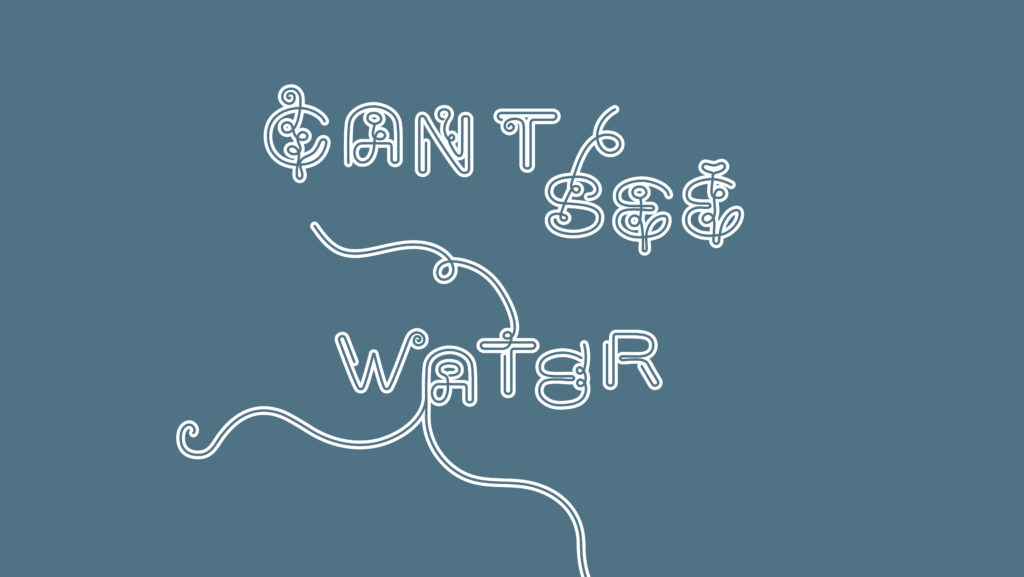Deep ocean surrounds the island and a soggy swamp surrounds the exhibition house. Massive waves and an endless abyss create visions of mythical creatures swimming around abandoned infrastructures, left there from an unknown time. The water moves towards the shore, carrying layers of time and ruins of the past. The heavy darkness of the depths of the ocean hides many secrets, and legends tell of monsters, terrifying when woken from their eternal sleep. When wandering in the swampy grounds, the sounds of those whose voices have not been heard are by their side.
This exhibition stems from the surrounding darkness. It starts from the feeling that the world is crumbling in our hands, while a strong wind blows the last of its remains even further. We cannot see the ever-growing threat of ecological destruction, just as we cannot see the potential new directions and life forms rising from the ruins of the old world.
Can’t See is divided into four chapters, which will provide a glimpse into spaces and times that are not usually perceived by the human eye: from the depths of the sea and layers beneath the soil to the debris of the past and visions of the future. The stories are told from a range of perspectives, from hybrid birds to bacteria, sea creatures, an ancient tree or the ever blasting wind, aiming to present different ways of seeing and experiencing the world that detach from the numerous perspectives we are accustomed to. The moment in time is not fixed, allowing us to travel deep into the mythical past or imagine futures yet to come.
Anna Niskanen (b. 1990) is a Finnish visual artist who lives and works in Helsinki and works with alternative photographic processes, creating large-scale installations of handmade prints. An overarching theme in her body of work is the memory of place and nature.
Edith Karlson (1983) is a sculptor, and the main protagonists in her work are people and animals. Dogs, bears, lions, birds and other animals appear allegorically or symbolically. The figures refer to fears, which arise from working as an artist, but also from functioning in the society. Generally, she presents her work as an installation, involving the whole exhibition space.
Edith Karlson has studied installation and sculpture at the Estonian Academy of Arts (BA, 2006; MA, 2008). She has been awarded with EAA Young Artist’s Prize (2006) and Köler Prize People’s Choice Award (2015). Edith Karlson is among the recipients of the national artists’ salary between 2018-2020 and 2022-2024. She was awarded with Estonian Cultural Endowment’s main award (2020). She is representing Estonia at the 60th Venice Biennial. You can read more about her works from the Estonian Artists Database here.
Her films are in the IFA, Kadist Foundation and Centre Pompidou collections and have been screened at the Serpentine Gallery, UK, Centre Pompidou, France, and the Museum of Modern Art, New York and in numerous film festivals including in Rotterdam, Busan, and Oberhausen. Most recently she concluded her tenures at Art Explora and Cite des Art, which occurred on the heels of another significant residency at the MAK Center for Art and Architecture. She is a founder and currently co-directs Polar Film Lab, a collective for analogue film practice located in Tromsø, Norway and is a member of artist duo New Mineral Collective, recently commissioned for a new work by the First Toronto Biennial.
Guðrún Vera Hjartardóttir (b. 1966, Reykjavík) studied sculpture at the School of Arts and Craft School in Reykjavík the years 1987 – 1991, Mixed Media at AKI – Akademie Voor Beeldende Kunst in Enschede, the Nether-lands, in the years 1991 – 1994 (BA) and Pedagogy of Art at the Iceland University of the Arts 2009 – 2011 (MA). She focuses on sculpture and installations and has exhibited her work around Europe, United States and Iceland.
Gústav Geir Bollason (b. 1966) is an artist and filmmaker who lives in the north of Iceland, in the small coastal village of Hjalteyri, where he manages the local art space “Verksmiðjan á Hjalteyri”. Bollason’s artistic practice is primarily a response to the landscape and the life it harbours. Creating drawings, found-object sculptures, animations, videos, and films, he often combines these media in installations that give rise to fictional extensions of reality.
Katja Novitskova (1984) deals in her work with the depiction of evolutional development, using internet as the source of visual data. In the early 2010s, she was among the first artists, who took post-internet for subject matter and designed its aesthetics.
